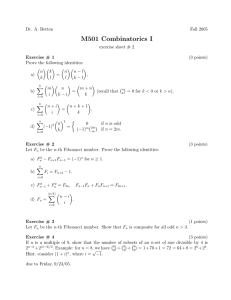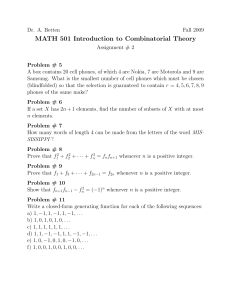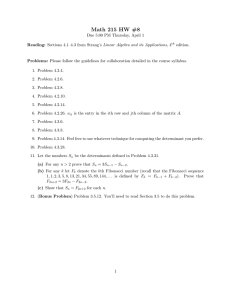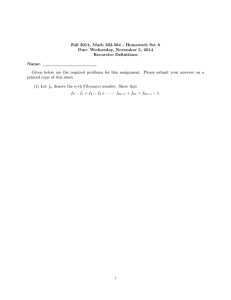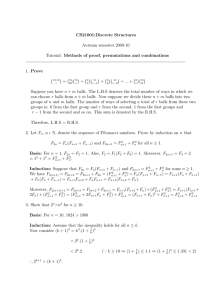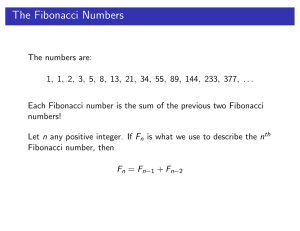18.S34 PROBLEMS #2
advertisement
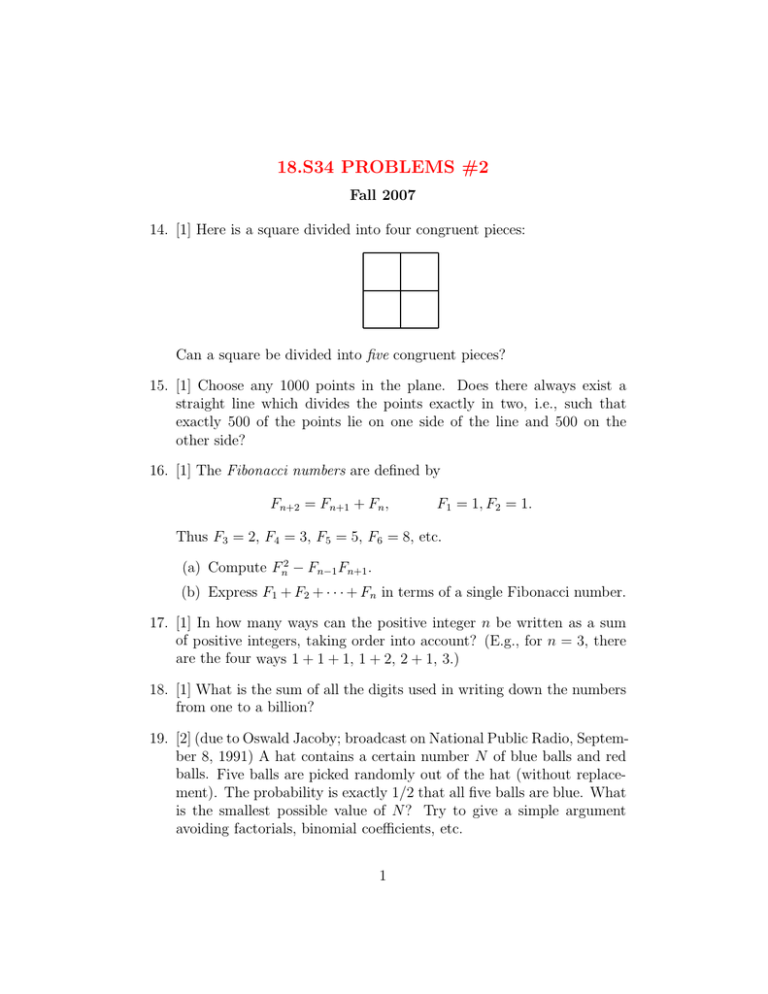
18.S34 PROBLEMS #2 Fall 2007 14. [1] Here is a square divided into four congruent pieces: Can a square be divided into five congruent pieces? 15. [1] Choose any 1000 points in the plane. Does there always exist a straight line which divides the points exactly in two, i.e., such that exactly 500 of the points lie on one side of the line and 500 on the other side? 16. [1] The Fibonacci numbers are defined by Fn+2 = Fn+1 + Fn , F1 = 1, F2 = 1. Thus F3 = 2, F4 = 3, F5 = 5, F6 = 8, etc. (a) Compute Fn2 − Fn−1 Fn+1 . (b) Express F1 + F2 + · · · + Fn in terms of a single Fibonacci number. 17. [1] In how many ways can the positive integer n be written as a sum of positive integers, taking order into account? (E.g., for n = 3, there are the four ways 1 + 1 + 1, 1 + 2, 2 + 1, 3.) 18. [1] What is the sum of all the digits used in writing down the numbers from one to a billion? 19. [2] (due to Oswald Jacoby; broadcast on National Public Radio, Septem­ ber 8, 1991) A hat contains a certain number N of blue balls and red balls. Five balls are picked randomly out of the hat (without replace­ ment). The probability is exactly 1/2 that all five balls are blue. What is the smallest possible value of N? Try to give a simple argument avoiding factorials, binomial coefficients, etc. 1 20. [2] (appeared in a letter from Martin Gardner to Marilyn Vos Savant, Parade, September 8, 1991) The Greens and Blacks are playing bridge. After a deal, Mr. Brown, an onlooker, asks Mrs. Black: “Do you have an ace in your hand?” She nods. There is a certain probability that her hand holds at least one other ace. After the next deal, he asks her: “Do you have the ace of spades?” She nods. Again, there is a certain probability that her hand holds at least another ace. Which probability is greater? Or are they both the same? 21. [2.5] Let d be any divisor of an integer of the form n2 + 1. Prove that d − 3 is not divisible by 4. 22. [2] A movie screen of height h is mounted on a vertical wall at a distance d from a floor which makes an angle of � with the wall. How far from the wall should a customer sit to get the best possible view? (Here you will have to make some reasonable assumption about what is meant by “best possible.” Try to avoid the use of trigonometry and/or calculus.) h d θ x 23. [2] Let Fn be a Fibonacci number, as defined above. � (a) Show that Fn = �15 (� n −�¯n ), where � = 12 (1+ 5) = 1.61803398· · ·, � �¯ = 12 (1 − 5) = −.61803398· · ·. Deduce that Fn is the nearest � integer to � n / 5. 2 (b) Show that 1 F12 + F22 + · · · + Fn2 = (F2n+3 − F2n−1 − (−1)n ). 5 24. [3.5] Do there exist relatively prime positive integers a, b with the fol­ lowing property? Define u1 = a, u2 = b, and un = un−1 + un−2 for n � 3. Then all the numbers un , n � 1, are composite. 25. [3] Define a sequence a1 < a2 < · · · of positive integers as follows. Pick a1 = 1. Once a1 , . . . , an have been chosen, let an+1 be the least positive integer not already chosen and not of the form ai + i for 1 � i � n. Thus a1 + 1 = 2 is not allowed, so a2 = 3 and a3 = 4. Now a2 + 2 = 5 is also not allowed, so a4 = 6, etc. The sequence begins 1, 3, 4, 6, 8, 9, 11, 12, 14, 16, 17, 19, . . .. Find a simple formula for an . Your formula should allow you, for instance, to compute a1000000 quickly� using a hand calculator. (Hint: The answer involves � = 1 (1 + 5).) 2 26. [2] Lines are drawn from the vertices of a square to the midpoints of the sides as shown below. � �� � ��� �� � � � ��� � � � � � �� � � What is the ratio of the area of the original square to the area of the center square S? Can you solve the problem without making any arithmetic or algebraic calculations? 27. Let � be any positive real number. We are given an ordinary cylindrical cake with frosting on the top. Cut out a piece in the usual manner which makes an angle of � (radians), turn it upside-down, and put it back in the cake. Then cut out another piece adjacent to the first piece (say in a clockwise direction) of the same size, and again turn it upside­ down and put it back in the cake. Continue. Each piece is clockwise adjacent to the previous piece. Prove that after finitely many steps, all the frosting will be back on top! 3
